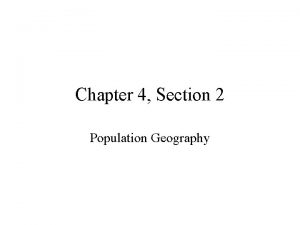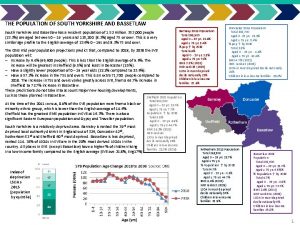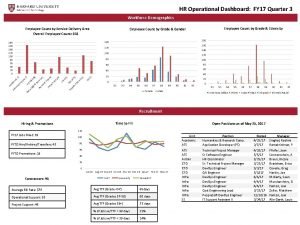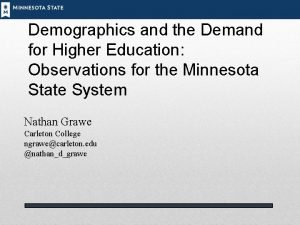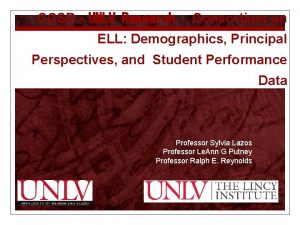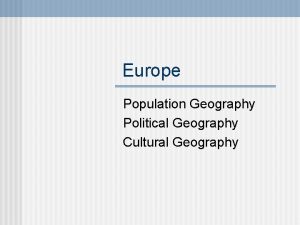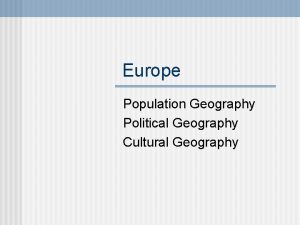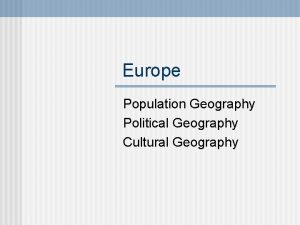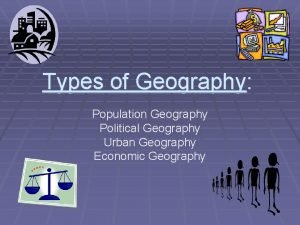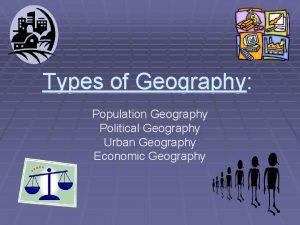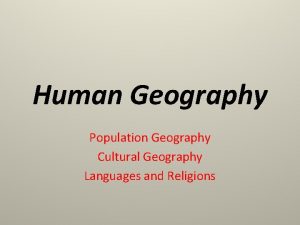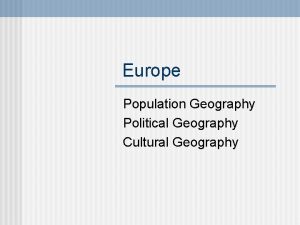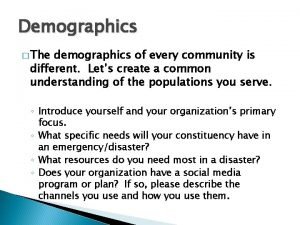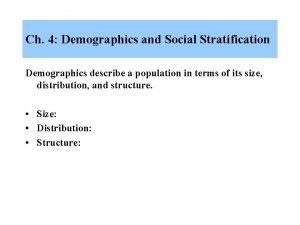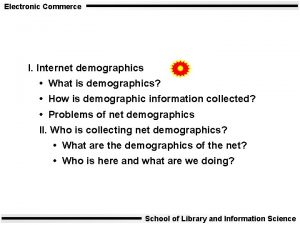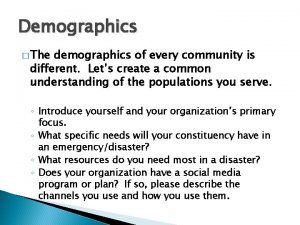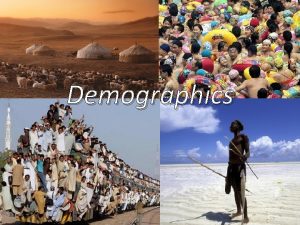Population Geography Chapter 2 Population Demographics is the






















- Slides: 22

Population Geography Chapter 2

Population • Demographics is the study of human population distribution and migration. • Key Issues of Demographics are: – Food Supply – Health and life expectancy – Status of women – Migration

People are NOT distributed evenly across the Earth. Population is clustered in the mid latitude climates and relatively sparse in the dry and polar climates or the highlands.


Crude Birth Rate

Total Fertility Rate (TFR) of 2. 1 to 2. 5 children per woman is considered “replacement level. ”

Crude Death Rates


FLife Expectancy : The average number of years an individual can be expected to live, given current social, economic, and medical conditions.

Dependency Ratio • The number of people under the age of 15 and over age 64, compared to the number of people active in the labor force.

Cholera in London, 1854 Fig. 2 -23: By mapping the distribution of cholera cases and water pumps in Soho, London, Dr. John Snow identified the source of the water -borne epidemic.

Population Pyramids – Charts that show the percentages of each age group in the total population, divided by gender. For poorer countries, the chart is shaped like a pyramid. Infant mortality rates are high, life expectancy is shorter.

Population Pyramids Charts that show the percentages of each age group in the total population, divided by gender. For wealthier countries, the chart is shaped like a lopsided vase. Population is aging, TFRs are declining.

Population Policies • Expansive Policies or Pro. Natalist policies encourage large families e. g. Fascist Italy, Nazi Germany, Soviet Union & Ceausescu’s Romania & Mao’s China. • Eugenic Population Policy -Nazi Germany favored “Aryans” over mentally ill or other undesirables. • The Nazis tried to breed the super race of Nordic or Aryan types.

Population Policies • Restrictive or Anti-Natalist Policies discourage births. • Policies vary- e. g. despite Vatican policies, most Catholic Italians practice artificial birth control-Philippines (only Asian Catholic country) a different case-govt. restricts birth control. • Some countries have learned that industrialization & urbanization do as much as government policy in controlling births.

China’s One Child Policy What are some of the limitations, unintended consequences, and contradictions found in government policies toward population growth?


Geography of Demography • China’s One-Child Policy created a generation of 90 million • 119 boys for every 100 girls • 30 million unmarried men by 2020 • 45% of Chinese women said they don’t intend to wed. • 3/10 families have grandparents living with them • Biggest demographic revolution in history-Number of Elderly is rising -by 2050 about 30% of the population will be over 60 -no pensions or social security.

• In 1798 he published An Rev. Thomas Malthus Essay on the Principle of 1766 -1834 Population • Malthus was the first to sound the alarm that the world’s population was expanding more rapidly than food production. • He was the first to recognize exponential or geometric population growth. • Today those who share his concerns are Neo. Malthusians

Food & Population, 1950 -2000 Malthus vs. Actual Trends Fig. 2 -20: Malthus predicted population would grow faster than food production, but food production actually expanded faster than population in the 2 nd half of the 20 th century.

Thomas Malthus Neo-Malthusians Critics of Malthus §Population is growing faster than Earth’s food supply §Population increased geometrically; food supply increased arithmetically • Transfer of medical technology leads to a rapid increase in population in poor countries • World population is outstripping a wide variety of resources • Wars and civil violence will increase because of scarcity of food and other resources • Large populations stimulate economic growth • Poverty, hunger, and other social welfare problems are a result of unjust social and economic institutions

Malthus Theory and Reality • Food production increased more rapidly than predicted because of technology. – Internal combustion engines – Artificial fertilizers – Pesticides – Irrigation pumps – Advanced plant and animal hybridization techniques – Refrigeration – Tin can for packaging
 Chapter 4 section 1 population dynamics
Chapter 4 section 1 population dynamics Chapter 4 population ecology section 1 population dynamics
Chapter 4 population ecology section 1 population dynamics Chapter 4 section 2 population geography
Chapter 4 section 2 population geography Walmart shopper demographics
Walmart shopper demographics Uf demographics
Uf demographics Yorkshire population
Yorkshire population Sfa demographics
Sfa demographics Orange county demographics
Orange county demographics What was harvard named after
What was harvard named after Sfa demographics
Sfa demographics Luxury consumer demographics
Luxury consumer demographics Nfl swot analysis
Nfl swot analysis Hr operations dashboard
Hr operations dashboard Matri shakti bima yojana
Matri shakti bima yojana Bexley demographics
Bexley demographics Demographics and the demand for higher education
Demographics and the demand for higher education Unlv demographics
Unlv demographics Lambert high school demographics
Lambert high school demographics Chinatown chicago demographics
Chinatown chicago demographics Demographics media studies
Demographics media studies Wine consumer demographics
Wine consumer demographics Candy crush versus
Candy crush versus South tyrol demographics
South tyrol demographics


